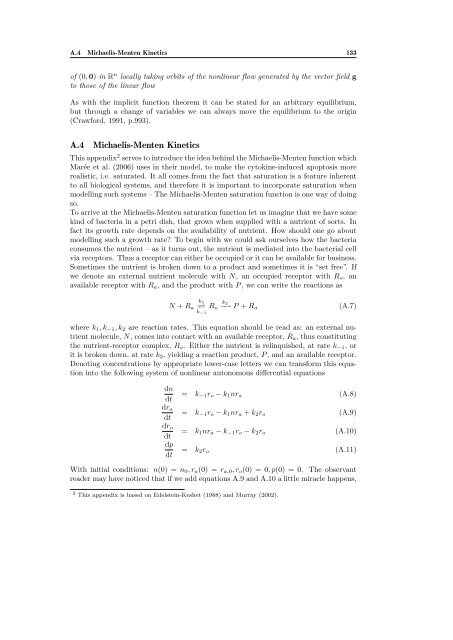nr. 477 - 2011 - Institut for Natur, Systemer og Modeller (NSM)
nr. 477 - 2011 - Institut for Natur, Systemer og Modeller (NSM)
nr. 477 - 2011 - Institut for Natur, Systemer og Modeller (NSM)
Create successful ePaper yourself
Turn your PDF publications into a flip-book with our unique Google optimized e-Paper software.
A.4 Michaelis-Menten Kinetics 133<br />
of (0, 0) in R n locally taking orbits of the nonlinear flow generated by the vector field g<br />
to those of the linear flow<br />
As with the implicit function theorem it can be stated <strong>for</strong> an arbitrary equilibrium,<br />
but through a change of variables we can always move the equilibrium to the origin<br />
(Craw<strong>for</strong>d, 1991, p.993).<br />
A.4 Michaelis-Menten Kinetics<br />
This appendix 2 serves to introduce the idea behind the Michaelis-Menten function which<br />
Marée et al. (2006) uses in their model, to make the cytokine-induced apoptosis more<br />
realistic, i.e. saturated. It all comes from the fact that saturation is a feature inherent<br />
to all biol<strong>og</strong>ical systems, and there<strong>for</strong>e it is important to incorporate saturation when<br />
modelling such systems – The Michaelis-Menten saturation function is one way of doing<br />
so.<br />
To arrive at the Michaelis-Menten saturation function let us imagine that we have some<br />
kind of bacteria in a petri dish, that grows when supplied with a nutrient of sorts. In<br />
fact its growth rate depends on the availability of nutrient. How should one go about<br />
modelling such a growth rate? To begin with we could ask ourselves how the bacteria<br />
consumes the nutrient – as it turns out, the nutrient is mediated into the bacterial cell<br />
via receptors. Thus a receptor can either be occupied or it can be available <strong>for</strong> business.<br />
Sometimes the nutrient is broken down to a product and sometimes it is “set free”. If<br />
we denote an external nutrient molecule with N, an occupied receptor with Ro, an<br />
available receptor with Ra, and the product with P , we can write the reactions as<br />
N + Ra<br />
k1<br />
⇋ Ro<br />
k−1<br />
k2<br />
−→ P + Ra<br />
(A.7)<br />
where k1, k−1, k2 are reaction rates. This equation should be read as: an external nutrient<br />
molecule, N, comes into contact with an available receptor, Ra, thus constituting<br />
the nutrient-receptor complex, Ro. Either the nutrient is relinquished, at rate k−1, or<br />
it is broken down, at rate k2, yielding a reaction product, P , and an available receptor.<br />
Denoting concentrations by appropriate lower-case letters we can trans<strong>for</strong>m this equation<br />
into the following system of nonlinear autonomous differential equations<br />
dn<br />
dt = k−1ro − k1<strong>nr</strong>a (A.8)<br />
dra<br />
dt = k−1ro − k1<strong>nr</strong>a + k2ro (A.9)<br />
dro<br />
dt = k1<strong>nr</strong>a − k−1ro − k2ro (A.10)<br />
dp<br />
dt = k2ro (A.11)<br />
With initial conditions: n(0) = n0, ra(0) = ra,0, ro(0) = 0, p(0) = 0. The observant<br />
reader may have noticed that if we add equations A.9 and A.10 a little miracle happens,<br />
2 This appendix is based on Edelstein-Keshet (1988) and Murray (2002).
















